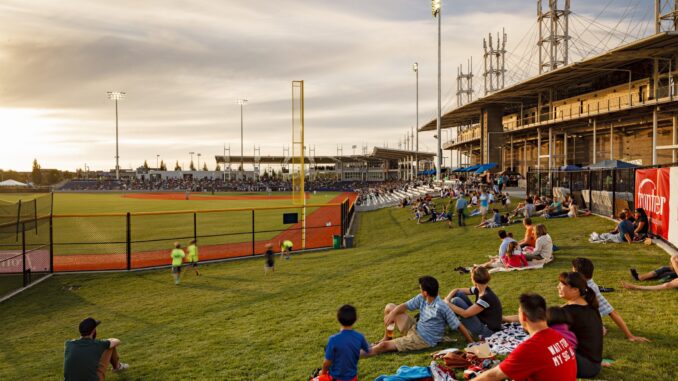
Whether it is ready or not, Oregon will soon face a reckoning for most professional sports stadiums.
Funding for stadium upgrades for both of the state’s minor league baseball teams, the Eugene Emeralds and Hillsboro Hops, is currently up in the air as a deadline from major league baseball to secure funding for the upgrades passed at the end of September without the teams being able to secure public funding for the upgrades.
It’s not just the Hops and Emeralds facing tough decisions for their future homes; the Portland Trail Blazers will be in a similar situation soon enough. The Moda Center hasn’t had any significant updates since it was constructed in 1995, and while current owner Jody Allen doesn’t figure to push the city or state hard on either constructing a new arena or upgrading the current one, a new future owner, without ties to the region, certainly could. And as fans in Seattle found out with the Supersonics, and baseball fans in Eugene and Hillsboro are currently learning, don’t expect a professional sports league to err on the side of nostalgia when trying to get new homes for their teams.
The baseball battle.
For the state’s two minor league baseball teams, each took two different tracks to the current stadiums and two different tracks to their Major League Baseball-mandated upgrades.
The Emeralds currently play at PK Park, which they share with the University of Oregon baseball team. When they were a short-season minor league team, this was typically not a problem as they did not start play until June, after the college season was done. However, now that they are a full-season High-A team, which came about as part of a contraction of minor league teams by Major League Baseball a few years ago, they compete with the Ducks for home dates in the first half of the season.
However, the proposed cost of the stadium has increased from its originally proposed budget, and the Emeralds are now asking taxpayers to help fill a gap of around 30 million dollars.
Meanwhile, in Hillsboro, the Hops’ current home, Ron Tonkin Field, was built for a mere $15 million a decade ago and is part of a sports complex that houses numerous fields for youth and rec leagues. Several of those fields would be bulldozed to make room for a larger stadium, which would be operated by the Hops.
The Hops asked the state to fill around $30 million in funding gaps for the stadium, but that proposal died during the last legislative session.
If neither team can cover the gaps in their funding, both would likely move in the near future. Make no mistake about it: Major League Baseball created this situation entirely on purpose. The league sought to overhaul the minor leagues after a 2020 lawsuit led to them increasing pay for minor leaguers across the boards, and that was followed by minor league players unionizing. In response, Major League Baseball contracted minor league teams nationwide, vastly reducing the number of minor league players. Oregon’s third minor league team, the Salem-Keizer Volcanoes, was among the victims. Teams with more modern stadiums were largely left untouched. However, MLB pledged that all stadiums would have to meet several criteria to allow teams to continue. Those included increased seating capacity and amenities such as permanent visitors’ clubhouses.
With neither Eugene nor Hillsboro meeting those criteria, they are now looking to build new stadiums less than 20 years after moving into sparkling new homes. Taxpayers in the state and local areas may wonder why they should have to foot the bill to build new homes for the teams when their current stadiums are perfectly adequate or they face losing their team. The answer is because Major League Baseball, when it contracted teams, has now created a market of scarcity-i.e., if Eugene and Hillsboro don’t pony up, one of the cities that lost their team a few years back probably will.
Among the fierce ironies of the debate over funding the stadiums is that opponents to spending taxpayer dollars wonder if adding a major league baseball team to Portland would not devalue the new stadiums constructed for minor league teams in Hillsboro and Eugene. It probably would to some extent, but if an agreement can’t even be reached to fund minor league stadiums, it’s hilarious to imagine that one could even be reached to spend taxpayer dollars on a big-league stadium.
Is Moda the next front?
If the state legislature could not manage to pull together what amounts to less than $50 million total for the two minor league teams, there is zero reason to see them coming up with larger sums for a major league baseball stadium or helping renovate the Moda Center. You can bet the possibility of Moda Center improvements has come up in discussions with the WNBA to land an expansion team for the city.
Efforts to improve the Moda Center are complicated. The building was initially built using a mix of public and private funds but was purchased by Paul Allen outright in 2007 and is now owned by his estate. The Trail Blazers, the primary tenant, also owned by Allen’s estate, have a lease to play in the building through 2025. The City of Portland currently has far higher priorities than spending taxpayer dollars to renovate an NBA arena or build a new one, considering the city government vacillates between “non-functional” and “complete disarray.” With the city’s governance structure changing in the next year and Jody Allen’s future ownership of the franchise murky at best, trying to pin anyone into funding a long-term project that will be seen through to the end is a slippery task at best.
If Allen commits to the long-term ownership of the franchise or sells to a local owner whose estate would help guarantee a long-term commitment, that should help make the negotiations go fairly smoothly. However, if 2025 arrives, no progress has been made on renovation funding, and Allen decides to sell to the highest out-of-town bidder, things figure to get brutal in a hurry. A new ownership group would likely ask Portland to pony up a significant sum to either completely renovate the Moda Center or build a new arena. Portland would, in turn, ask the State of Oregon to pitch in. As the negotiations with the Hops and Emeralds have shown, getting money from the state is not necessarily an easy task.
As the adage about government spending goes, “A billion here, a billion there, and pretty soon you’re talking real money.” When it comes to funding the Hops and Emeralds, the state failed to come up with the government budget equivalent of pocket change, leading to the very likely outcome of both teams leaving the state. One doesn’t have to stretch the imagination very far to imagine what would happen if the state can’t come up with a more substantial sum of money to meet the demands of its most popular professional sports franchise.
The day of reckoning is already here for the state’s two professional baseball teams, and have no doubt about it: the day is coming sooner rather than later for the Moda Center and the Blazers.
The question is, will Oregon be ready for it?




